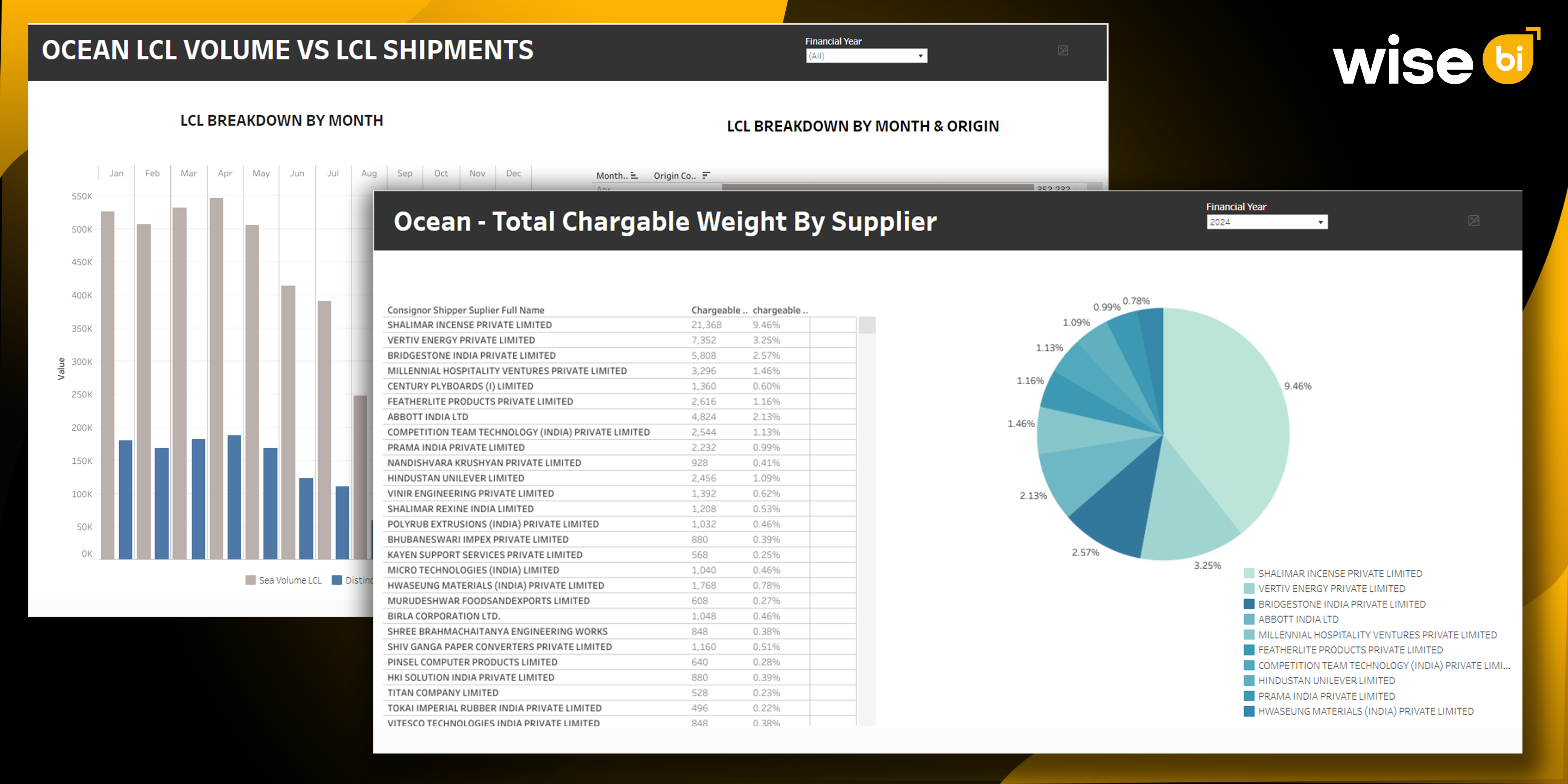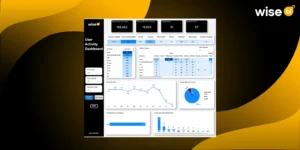Global supply chains are more uncertain than ever. From port congestion and rising freight costs to geopolitical disruptions and meeting customer demands, logistics professionals are confronted with difficulties that old approaches cannot address. Numerous logistics companies react after the fact, with no clear picture of what’s going on in their network or why. That’s where business intelligence (BI) comes in as a game changer.
BI technologies convert disparate logistics data into real-time insights, allowing businesses to spot delays early on, optimize shipment routes, manage supplier performance, and foresee future hazards. That is why freight forwarders need BI dashboards in today’s logistics world to remain agile and data-driven in the face of rapid change.
In this blog, we’ll explore how logistics companies are leveraging BI solutions to overcome global supply chain challenges in today’s competitive landscape.
BI Transforms Global Supply Chain Chaos Into a Streamlined, Smart Operation
Gain Real-Time Visibility Across the Supply Chain
For logistics teams, not knowing where goods are at any given time is a dealbreaker. Real-time dashboards powered by BI allow you to track shipments from origin to delivery, monitor port delays, and view in-transit inventory all in one place. Visibility is no longer a luxury; it’s a baseline expectation.
- Monitor live shipment status and ETAs.
- Identify bottlenecks in the transport process.
- Share real-time updates with clients or partners.
This level of visibility helps operations teams act fast when problems occur and provides customer service teams with the insights they need to respond confidently. With real-time tracking, your teams can anticipate rather than react, making operations smoother and customer satisfaction higher.
Predict Disruptions Before They Cost You
BI platforms don’t just show you what’s happening now; they can predict what might happen next. Using historical data and trend analysis, predictive BI tools can help logistics managers anticipate seasonal demand, identify risk-prone trade lanes, and prepare for inventory surges.
- Forecast container volume by lane or region.
- Predict warehouse capacity issues before they occur.
- Build proactive plans for natural disasters or labor strikes.
This type of planning enables businesses to stay ahead of disruptions rather than scrambling to react when it’s too late. It enhances agility and prepares organizations for contingencies before they become emergencies.
Improve Financial Control and Margin Tracking
Logistics companies operate on tight margins, and every shipment comes with a stack of costs. With BI dashboards, you can analyze profit and loss per route, vendor, customer, or product—helping you spot where money is gained or lost. Better visibility into cost centers leads to better profitability.
- Track revenue and cost per shipment.
- Compare branch or region profitability.
- Monitor vendor overcharges and billing discrepancies.
Finance and operations teams can use these insights to optimize billing cycles, eliminate leakages, and improve cash flow. It becomes easier to align financial goals with operational realities, leading to smarter budgeting and forecasting.
Break Down Data Silos Across Teams and Systems
Global logistics operations often rely on multiple systems: TMS, WMS, ERP, and even spreadsheets. BI solutions unify these data sources into a single source of truth. That means your branch manager, your sales lead, and your CFO are all seeing the same numbers.
- Consolidate TMS, WMS, and ERP data.
- Create unified KPIs across departments.
- Enable better collaboration through shared dashboards.
By eliminating siloed data, decisions become more consistent, strategic, and faster to execute. Everyone stays on the same page, which leads to better coordination and faster results.
Enable Self-Service Insights for Non-Tech Teams
One of the most powerful features of modern BI tools is user-friendliness. Even team members without technical backgrounds can use drag-and-drop dashboards or prebuilt reports to get answers fast.
- Empower operations managers to build route analysis reports.
- Let sales teams access customer profitability data.
- Give warehouse managers insights into peak fulfillment hours.
Self-service BI improves agility and reduces the burden on IT teams to generate every report. It puts the power of data directly into the hands of decision-makers at every level.
Analyze Customer and Vendor Performance with Ease
Global logistics is a relationship-heavy business. Knowing which customers are your most profitable and which vendors are causing delays gives you the power to renegotiate terms or refocus efforts. The Customer Analysis Dashboard provides the following insights:
- Identify high-value or low-margin clients.
- Monitor vendor compliance and performance trends.
- Spot declining customer engagement early.
This data helps improve retention, elevate service levels, and strengthen your partnerships. Relationships built on data are smarter, more transparent, and ultimately more profitable.
Scale Operations Without Losing Control
As your logistics network grows, whether across more geographies, SKUs, or clients, so does the complexity. BI allows for scalable insights no matter how fast you expand. Growth shouldn’t mean chaos.
- Compare performance across branches or countries.
- Standardize metrics for global reporting.
- Customize dashboards for different leadership roles.
Whether you’re expanding into a new market or onboarding a new team, BI makes it easier to keep control. Scale should be a sign of success, not a new set of headaches.
Optimize Inventory and Warehouse Performance
Inventory mismanagement can lead to high holding costs or stockouts. BI tools allow you to monitor turnover ratios, stock levels, and order fulfillment trends with precision.
- View inventory aging by location.
- Analyze fulfillment times and order accuracy.
- Align stocking with demand forecasts.
These insights reduce waste, improve service, and keep working capital healthy. When your inventory works for you, you free up both space and cash flow.
Use AI and Automation for Smarter Workflows
Many BI platforms now integrate AI and machine learning to automate pattern detection, alert generation, and even next-step suggestions. Automation brings speed, accuracy, and scalability.
- Get alerts when shipment delays spike.
- Identify unusual vendor billing activity.
- Automate repetitive reporting tasks.
This frees up human teams to focus on strategic decisions while software handles the routine monitoring. AI acts as a co-pilot, helping you navigate complexity with confidence.
Customize Dashboards to Fit Every Role
One-size-fits-all dashboards often confuse more than they help. The best BI tools allow for customization based on who is using them. The right data, at the right time, in the right hands.
- Branch managers can monitor shipments and margins.
- Executives can track profitability and growth.
- Sales can see account-level trends and opportunities.
This personalization ensures every team member is aligned with goals that matter most to them. When dashboards speak your language, they become tools, not obstacles.
The Future of Logistics Is Data-Driven
As the logistics industry continues to evolve, the companies that will lead are those that harness the power of data effectively. BI isn’t just about seeing what happened; it’s about knowing what’s happening now, predicting what comes next, and making smarter choices across the board. Whether it’s tackling shipping delays, managing costs, or retaining high-value customers, BI has become a critical tool for every logistics operation looking to stay competitive.
Conclusion
As global supply networks become increasingly complicated, reactive decision-making is no longer acceptable. Logistics companies require a proactive strategy supported by reliable data. BI solutions help companies in transitioning from instinct-based decisions to insight-driven operations, lowering uncertainty, increasing service, and controlling expenses. If you want to future-proof your supply chain and respond faster to disturbances, it’s time to put business intelligence to work.
Contact us today and explore how BI can help your team make smarter, faster, and more reliable supply chain decisions.




